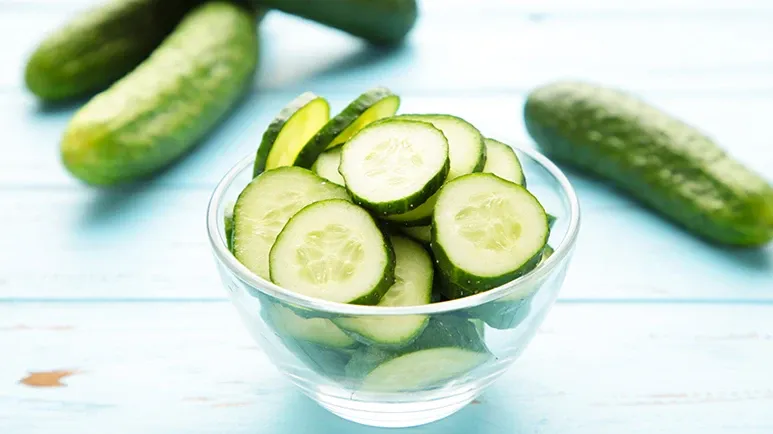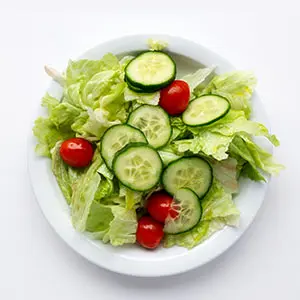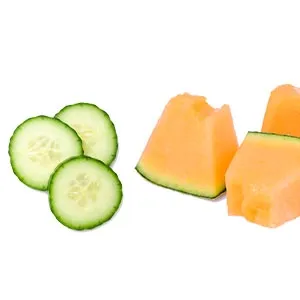Cucumber: Could This Hydrating Veggie Be Your Pet's New Favorite on Hot Days?
Commonly added to salads, this crunchy and refreshing veggie is composed of 95% water, and can rehydrate your pet during sunny days.

STORY AT-A-GLANCE
- Cucumbers are composed of 95% water, which may help quench your pet's thirst during a hot summer day
- They also contain various nutrients that may help support your pet's health, such as vitamin K, vitamin C, beta-carotene and cucurbitacin, which has anticancer properties
- Commercially grown cucumbers typically contain pesticides, so buy organic, or wash them in running cold water or in a 2% salt water solution
- Slice cucumbers into bite-sized bits to ensure that your pet does not choke on this food
- Remember that healthy treats like cucumber should make up less than 10% of your pet's daily caloric intake
Editor's Note: This article is a reprint. It was originally published November 6, 2018.
After a whole afternoon of playing out in the sun, no doubt your pets come home hungry and thirsty, probably looking for a yummy treat. Here's a refreshing food you can give them: fresh cucumber slices!
Cucumbers are composed of 95% water,1 which may help quench your pet's thirst during a hot summer day. Various factors such as humidity, temperature and your dog's fitness level can affect their ability to cool off,2 and giving your pet some cucumber slices is a simple way of helping increase their fluid intake. It's one of the most rehydrating snacks your pet can munch on.
But the fun doesn't stop there — with a bit of creativity, cucumbers can also be added to your pet's nutritionally adequate, species-appropriate diet.
Cucumber Fun Fact

Cucumbers are a staple ingredient in salads, but did you know that they're actually a fruit? They belong to the cucurbitaceae family, which includes melon, watermelon and squash.3
Phytonutrients in Cucumbers Can Boost Your Pet's Health
In-depth studying of cucumbers has yielded some interesting insights. In a 2010 study, for example, researchers discovered that cucumbers possess phytonutrients that contain free radical-scavenging and analgesic properties within an animal model setting.4
Going more in-depth, cucumbers contain cucurbitacin, which has anticancer, anti-atherosclerotic and antidiabetic potential.5 Vitexin has been found in cucumbers as well,6 which a 2013 study has noted to have "antioxidant, anticancer, anti-inflammatory, anti-hyperalgesic and neuroprotective effects."7
It's clear that the phytonutrients in cucumbers may help boost your pet's health, but did you know that they may help keep your pet's breath fresh as well? According to nutritionist Keri Glassman, the water in cucumber may help wash away food residue in the mouth,8 and the same effect may apply to your pet as well.
Vitamins and Fiber in Cucumber Can Support Pets’ Well-Being
Cucumber contains various nutrients that may support your pet's health. A couple of tablespoons contain 0.73 micrograms of beta-carotene, 0.26 micrograms of vitamin K and 0.04 milligrams of vitamin C.9
Beta-carotene is a precursor phytonutrient that may help maintain proper eyesight in dogs, along with other carotenoids.10 In addition, it may help with improving immune response in older dogs, according to a study published in the Journal of Veterinary Internal Medicine.11
As for vitamin C, animals need it just as much as humans do. According to a study published in the Canadian Journal of Veterinary Research, vitamin C acts as a "cofactor for enzymes involved in the biosynthesis of collagen, carnitine and norepinephrine."12 Vitamin C has antioxidant capabilities, as well as immune-boosting functions.13 Meanwhile, animal models have shown that vitamin K is a cofactor for bone metabolism and blood coagulation.14
Last but not least is the fiber present in cucumber, coming in at 0.008 grams for every two tablespoons.15 The benefits of fiber for human health have been praised many times over, and the amazing part about it is that your pet can enjoy the same benefits as well. According to a study published in Research in Veterinary Science, fiber:16
"… can modify the intestinal microflora by promoting commensal bacteria growth; decrease in gastric emptying, blood cholesterol concentrations, gastric transit time, dilution in diet calorie density as well as increase in satiety, glucose uptake rate and fecal excretion …"
Did You Know?

When you slice a fresh cucumber, have you ever noticed that it smells similar to a melon? That's because both fruits contain an aldehyde called trans,cis-2,6-nonadienal.17
How to Give Cucumbers Safely to Your Pets
Misinformation about many healthy fruits, vegetables, nuts and seeds abounds on the internet. This is because websites have labeled all risks (such as the risk of over-consumption causing gastrointestinal issues, or choking on too large of pieces or pits) as "toxicities," which isn't true but has managed to confuse millions of pet lovers, nonetheless.
"The truth is that cucumbers are safe for pets, as long as you prepare them correctly and give them in the right quantities."
It's important to slice cucumbers into bite-sized bits to ensure that your pet does not choke on this food.18 The American Society for the Prevention of Cruelty to Animals (ASPCA) says cucumbers are nontoxic for felines too,19 but don't be surprised if your cat won't eat them because they are obligate carnivores. However, if your cat does change their mind, you can feed them a few small bites of this crunchy food.
The Top Cucumber Producers in the US

Florida takes the top spot when it comes to fresh cucumbers, while Michigan is the choice for cucumbers used for pickling. During the winter months, Mexico becomes the top exporter of cucumbers to the U.S.20

Tips in Preparing and Feeding Cucumbers
When purchasing cucumbers, look for certified organic providers or spray-free options whenever possible. According to the Environmental Working Group (EWG), cucumbers come in at No. 32 in their "2025 Shopper's Guide to Pesticides in Produce."21
If you can't source organic cucumber for your household, the next best strategy is washing regular cucumbers in running cold water, which can help remove 75% to 80% of pesticides from the skin. Washing cucumbers with a 2% salt water solution can also help remove most pesticide residue.22
With that being said, what's the best way to feed cucumber to your pet so they can get all the nutrients? Raw, of course! There are two ways you can do this, according to Dogster:23
- Slices — Create bite-sized slices that your pet can easily eat.
- Garnish — You can add cucumber bits as "healthy toppers" to your dog's nutritionally balanced meal.
Remember that healthy treats like cucumber should make up less than 10% of your pet's daily caloric intake.
Sources and References
- 1 Cleveland Clinic, Dehydrated? These 7 Foods Will Satisfy Your Thirst and Hunger (Archived)
- 2 Front Vet Sci. 2017; 4: 174, Introduction
- 3 Britannica, List of Plants in the Family Cucurbitaceae
- 4 J Young Pharm. 2010 Oct-Dec; 2(4): 365–368, Results and Discussion
- 5 Pharmacogn Rev. 2015 Jan-Jun; 9(17): 12–18, Bioactivity
- 6 Fitoterapia. 2013 Jan;84:227-36, Abstract
- 7 Fitoterapia. 2016 Dec;115:74-85, Abstract
- 8 Today, May 26, 2017
- 9,15 USDA FoodData Central, Cucumber, with peel, raw
- 10 The Journal of Nutrition, Volume 132, Issue 6, June 2002, Pages 1610S–1612S, Abstract (Archived)
- 11 J Vet Intern Med. Nov-Dec 2003;17(6):835-42, Abstract
- 12, 13 Can J Vet Res. 2006 Oct; 70(4): 305–307
- 14 J Am Assoc Lab Anim Sci. 2007 Sep;46(5):8-12, Abstract
- 16 Research in Veterinary Science Volume 112, June 2017, Pages 161-166, Background
- 17 The Naked Scientists, February 18, 2021
- 18 AKC, March 26, 2024
- 19 The American Society for the Prevention of Cruelty to Animals, Cucumber
- 20 FDA, Cucumbers pg 2 (Archived)
- 21 EWG's 2025 Shopper's Guide to Pesticides in Produce™
- 22 Centre for Science and Environment, Removing Pesticides from Fruits and Vegetables
- 23 Dogster, February 6, 2025











